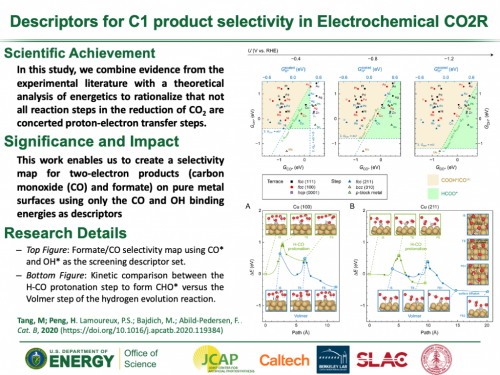Highlights
• Not all intermediary steps in CO2 reduction may be electrochemical.
• 2e- product selectivity can be rationalized with the CO and OH binding energies as descriptors.
• Electrochemical COH formation dominates over surface-driven CHO formation at −0.5 V vs. RHE.
•Atomic carbon is rationalized as a key intermediate in the formation of methane from CO2 reduction.
•CH to CH2 formation step strongly competes with HER on transition metal surfaces.
Electrochemical reduction of carbon dioxide (CO2RR) over transition metals follows a complex reaction network. In this study, we combine observations from experimental literature with a theoretical analysis of energetics to rationalize that not all intermediates in the reduction of CO2 are formed through direct protonation steps. We derive a selectivity map for two-electron products (carbon monoxide (CO) and formate) on pure metal surfaces using only the CO and OH binding energies as descriptors. For the pure metals that are selective towards CO formation, the variation of the CO binding energy is sufficient to further subdivide the map into domains that predominantly form H2, CO, and more reduced products. Our analysis rationalizes experimentally observed product distributions in CO2RR across pure metal systems. Overall, we highlight the need for additional material screening descriptors for CO2R and the importance of considering competition from the elementary steps of the hydrogen evolution reaction.
This material is based upon work performed by the Joint Center for Artificial Photosynthesis, a DOE Energy Innovation Hub, supported through the Office of Science of the U.S. Department of Energy under Award Number DE-SC0004993. We acknowledge the use of the computer time allocation for the Material Simulations in Joint Center for Artificial Photosynthesis (JCAP) at the National Energy Research Scientific Computing Center, a DOE Office of Science User Facility supported by the Office of Science of the U.S. Department of Energy under Contract No. DE-AC02-05CH11231. The authors thank Dr. Tej S. Choksi, Dr. Christopher Hahn, and Dr. Alan C. Luntz for insightful discussions and helpful suggestions.

